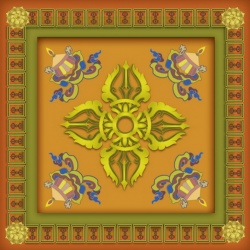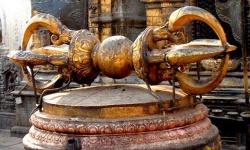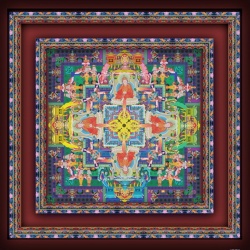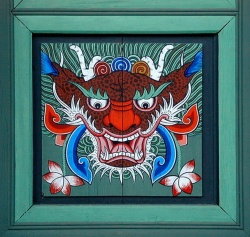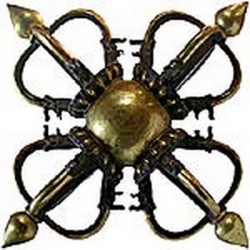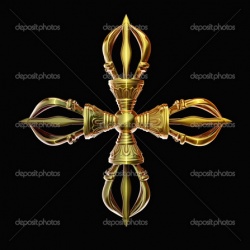Difference between revisions of "Three Vajras"
| Line 62: | Line 62: | ||
Nomenclature, {{Wiki|orthography}} and {{Wiki|etymology}} | Nomenclature, {{Wiki|orthography}} and {{Wiki|etymology}} | ||
| − | The [[Three Vajras]] is an English rendering of [[gsang ba gsum]] ([[Tibetan]]); which has variously been rendered as: Three Secrets, [[Three Mysteries]], Three Seats, [[Three Doors]] and Three Gateways. | + | The [[Three Vajras]] is an English rendering of [[gsang ba gsum]] ([[Tibetan]]); which has variously been rendered as: Three Secrets, [[Three Mysteries]], [[Three Seats]], [[Three Doors]] and [[Three Gateways]]. |
Another [[Tibetan]] {{Wiki|orthography}} that explicitly mentions [[Vajra]] ([[Tibetan]]: [[rdo-rje]]) is: [[rdo rje gsang ba gsum]]. | Another [[Tibetan]] {{Wiki|orthography}} that explicitly mentions [[Vajra]] ([[Tibetan]]: [[rdo-rje]]) is: [[rdo rje gsang ba gsum]]. | ||
| Line 109: | Line 109: | ||
| − | "The {{Wiki|trinity}} of [[body]], [[speech]], and [[mind]] are known as the three gates, three receptacles or [[three vajras]], and correspond to the {{Wiki|western}} [[religious]] {{Wiki|concept}} of righteous [[thought]] ([[mind]]), [[word]] ([[speech]]), and [[deed]] ([[body]]). | + | "The {{Wiki|trinity}} of [[body]], [[speech]], and [[mind]] are known as the [[three gates]], three receptacles or [[three vajras]], and correspond to the {{Wiki|western}} [[religious]] {{Wiki|concept}} of righteous [[thought]] ([[mind]]), [[word]] ([[speech]]), and [[deed]] ([[body]]). |
Latest revision as of 07:38, 25 December 2023
- See also :
- See also :
Three vajras (Skt. trivajra; Tib. dorje sum; Wyl. rdo rje gsum) —
- vajra body (Skt. kāyavajra; Wyl. sku'i rdo rje),
- vajra speech (Skt. vākvajra; Wyl. gsung gi rdo rje), and
- vajra mind (Skt. cittavajra; Wyl. thugs kyi rdo rje).
In Vajrayana, the three doors of human beings are considered to be, in essence, the three vajras or three secrets.
The Three Vajras namely 'body', 'speech' and 'mind' are a formulation within Tibetan Buddhism and Bon which holds the full experience of the 'openness' (Sanskrit:
śūnyatā) of Buddha-nature, void of all bar the 'qualities' (Wylie: yon-tan) and 'marks' ] (Wylie: mtshan-dpe) and establishes a sound experiential key upon the 'continuum of the path' to enlightenment.
In Japanese Buddhism they are known as the Three Mysteries (Japanese: san-mitsu).
The Three Jewels imply purity of action, speech and thought and therefore in Tibetan Buddhism the Three Vajras are viewed in The Twilight Language as a form of the Three Jewels.
The term is often mentioned in Vajrayana Buddhist discourse, particularly in relation to samaya, the vows undertaken between a practitioner and their guru during initiation.
The term is also used during Anuttarayoga Tantra practice.
The Three Vajras correspond to the Trikaya, or three bodies of a Buddha and therefore also have correspondences to the Three Roots and other refuge formulas of Tibetan Buddhism.
Nomenclature, orthography and etymology
The Three Vajras is an English rendering of gsang ba gsum (Tibetan); which has variously been rendered as:
Three Secrets, Three Mysteries, Three Seats, Three Doors and Three Gateways.
Another Tibetan orthography that explicitly mentions Vajra (Tibetan: rdo-rje) is: rdo rje gsang ba gsum.
The full Tibetan title may be rendered into English as 'the three secrets of the noble ones' (Tibetan: phags pa'i gsang ba gsum) which are: body (Tibetan: lus and sku); voice/speech (Tibetan: gsung) and mind (Tibetan: thugs).
Another full title: sku gsung thugs mi zad pa rgyan gyi 'khor lo may be rendered as "Inexhaustible adornment wheel of Body, Speech and Mind" where the term 'khor lo is the Tibetan term for chakra (Sanskrit).
The Three Vajras namely 'body', 'speech' and 'mind' are a formulation within Tibetan Buddhism and Bon which holds the full experience of the 'openness' (Sanskrit: śūnyatā) of Buddha-nature, void of all bar the 'qualities' (Wylie:
yon-tan) and 'marks' (Wylie: mtshan-dpe) and establishes a sound experiential key upon the 'continuum of the path' to enlightenment.
In Japanese Buddhism they are known as the Three Mysteries (Japanese: san-mitsu).
The Three Jewels imply purity of action, speech and thought and therefore in Tibetan Buddhism the Three Vajras are viewed in The Twilight Language as a form of the Three Jewels.
The term is often mentioned in Vajrayana Buddhist discourse, particularly in relation to samaya, the vows undertaken between a practitioner and their guru during initiation.
The term is also used during Anuttarayoga Tantra practice. The Three Vajras correspond to the Trikaya, or three bodies of a Buddha and therefore also have correspondences to the Three Roots and other refuge formulas of Tibetan Buddhism.
Nomenclature, orthography and etymology
The Three Vajras is an English rendering of gsang ba gsum (Tibetan); which has variously been rendered as: Three Secrets, Three Mysteries, Three Seats, Three Doors and Three Gateways.
Another Tibetan orthography that explicitly mentions Vajra (Tibetan: rdo-rje) is: rdo rje gsang ba gsum.
The full Tibetan title may be rendered into English as 'the three secrets of the noble ones' (Tibetan: phags pa'i gsang ba gsum) which are: body (Tibetan: lus and sku); voice/speech (Tibetan: gsung) and mind (Tibetan: thugs).
Another full title: sku gsung thugs mi zad pa rgyan gyi 'khor lo may be rendered as "Inexhaustible adornment wheel of Body, Speech and Mind" where the term 'khor lo is the Tibetan term for chakra (Sanskrit). Vajra Body
The Vajra Body (Tibetan: rdo rje'i lus; sku rdo rje; ).
In explicating the term rdo rje'i lus, the Dharma Dictionary states that it denotes: "The human body, the subtle channels of which resemble the structure of a vajra."
Vajra Voice
The Vajra Speech/Voice (Tibetan: rdo rje'i gsung; gsung rdo rje). In elucidating the term, the Dharma Dictionary states that it denotes: 'vajra speech', 'vajra words'.
Vajra Mind
The Vajra Mind (Tibetan: thugs rdo rje; Sanskrit: citta-vajra) is defined by the Dharma Dictionary as: mind vajra, vajra mind.
The Three Vajras are often employed in tantric sadhana at various stages during the visualization of the generation stage, refuge tree, guru yoga and yidam, or meditational deity, processes.
The concept of the Three Vajras serves in esoteric Twilight Language to convey polysemic meanings, aiding the practitioner to conflate and unify the mindstream of the meditational deity,
the guru and the sadhaka in order for the practitioner to experience their own Buddha nature.
Speaking for the Tibetan Nyingma tradition, Tulku Urgyen Rinpoche perceives an identity and relationship betwixt the Buddha Nature, Dharmadhatu (essence of all phenomena and the noumenon), the Dharmakaya, Rigpa (the "awakened state") and the Three Vajras, saying:
"Dharmadhatu is adorned with dharmakaya, which is endowed with dharmadhatu wisdom. This is a brief but very profound statement, because 'dharmadhatu' also refers to sugata-garbha or buddha nature.
Buddha nature is all-encompassing ...
This buddha nature is present just as the shining sun is present in the sky.
It is indivisible from the three vajras [i.e. the Buddha's Body, Speech and Mind] of the awakened state, which do not perish or change."
Robert Beer (2003: p. 186) states:
"The trinity of body, speech, and mind are known as the three gates, three receptacles or three vajras, and correspond to the western religious concept of righteous thought (mind), word (speech), and deed (body).
The three vajras also correspond to the three kayas,
with the aspect of body located at the crown (nirmanakaya),
the aspect of speech at the throat (sambhogakaya), and
the aspect of mind at the heart (dharmakaya)."
The seed syllables corresponding to the Three Vajras are:
a white om (enlightened body),
a red ah (enlightened speech) and
a blue hum (enlightened mind).
Gold (1994: p. 5), a once upon a time associate of Mead, after codifying his extensive ethnographic fieldwork with the Tibetan and Navajo peoples in his work of comparative Anthropology, stated:
...Om, is the most important mystic sound of Buddhism, for it expresses the sum of all sounds--forms of energy--permeating the totality of the cosmos.
And hum is the powerful aural agent for unifying the relative, conditioned, real-world state of mind with the unconditioned oneness of the cosmos as embodied in the Om. Hum, then, represents the act of merging the ideal with the real....
Simmer-Brown (2001: p. 334) asserts that:
When informed by tantric views of embodiment, the physical body is understood as a sacred maṇḍala (Wylie: lus kyi dkyil).
This explicates the semiotic rationale for the nomenclature of the Himalayan somatic discipline Trul Khor: Trul Khor may be rendered in English as "Magical Wheel".
The www.nitartha.org search results for lus kyi dkyil are: lus kyi dkyil 'khor body mandala [ry].
The triunic continua of body-voice-mind are intimately related to the esoteric Dzogchen doctrine of 'sound, light and rays' (Wylie: sgra 'od zer gsum) as a passage of the rGyud bu chung bcu gnyis kyi don bstan pa rendered into English by Rossi (1999: p. 65) states (Wylie provided for probity):
From the Basis (of) all, empty (and) without cause,
sound, the dynamic potential of the Dimension, arises.
From the Awareness, empty (and) without cause,
light, the dynamic potential (of) Primordial Wisdom, appears.
From the inseparability, empty (and) without cause,
rays, the dynamic potential of the Essence, appear.
When sound, light and rays are taken (as) instrumental causes
(that) ignorance (turns into) the delusion of body, speech (and) mind;
the result (is) wandering in the circle (of) the three spheres.
Kun gzhi stong pa rgyu med las/
sgra ni dbyings kyi rtsal du shar/
rig pa stong pa rgyu med las/
'od ni ye shes rtsal du shar/
dbyer med stong pa rgyu medlas/
zer ni thig le'i rtsal du shar/
sgra 'od zer gsum rkyen byas nas/
ma rtogs lus ngag yid du 'khrul/
bras bu khams gsum 'khor bar 'khyams//
Barron, et al. (1994, 2002: p. 159), renders from Tibetan into English, a terma 'pure vision' (Wylie: dag snang) of Sri Singha by Dudjom Lingpa that describes the Dzogchen state of 'formal meditative equipoise' (Tibetan: nyam-par zhag-pa) which is the indivisible fulfillment of vipaśyanā and śamatha, Sri Singha states:
"Just as water, which exists in a naturally free-flowing state, freezes into ice under the influence of a cold wind, so the ground of being exists in a naturally free state, with the entire spectrum of samsara established solely by the influence of perceiving in terms of identity.
Understanding this fundamental nature, you give up the three kinds of physical activity--good, bad, and neutral--and sit like a corpse in a charnal ground, with nothing needing to be done.
You likewise give up the three kinds of verbal activity, remaining like a mute, as well as the three kinds of mental activity, resting without contrivance like the autumn sky free of the three polluting conditions."
Kukkuraja's instruction to Garab Dorje
Kukkuraja's instruction to Garab Dorje entailed a teaching of the Three Vajras in relation to Vajrasattva, Atiyoga and Kulayaraja Tantra:
"Everything without exception is the Divine Body-Speech-Mind," he had said. "The Divine Body-Speech-Mind is all-encompassing.
Thus know your ultimate identity to be Vajrasattva, the Divine Body-Speech-Mind."
As the Tibetan text of the Kulaya-raja Sutra (Kun.byed.rgyal.po'i .mdo) states: "When everything is seen as the Great Self-identity (bdag.nyid.chen.po), it is known as Atiyoga."
Five fundamental aspects of an enlightened being
The Three Vajras are subsumed within the 'Five fundamental aspects of an enlightened being'. Namkhai Norbu et al. (2001: p. 176) lists the English rendering with the associated Tibetan language term:
represent the five fundamental aspects of an enlightened being.
Emanation theory and the five fundamental aspects of an enlightened being
Mindstream 'emanation' (Sanskrit: nirmana, nirmanakaya; Tibetan: sprul-sku, sprul-pa) theory is fundamentally related to the five fundamental aspects of an enlightened being:
mind emanation: thugs kyi sprul-sku
speech emanation: gsung gi sprul-sku
body emanation: sku yi sprul-sku
qualities emanation: yon tan sprul-sku
activities emanation: phrin las sprul-sku
Vajra Body
The Vajra Body (Tibetan: rdo rje'i lus; sku rdo rje; ). In explicating the term rdo rje'i lus, the Dharma Dictionary states that it denotes: "The human body, the subtle channels of which resemble the structure of a vajra."
Vajra Voice
The Vajra Speech/Vajra voice (Tibetan: rdo rje'i gsung; gsung rdo rje).
In elucidating the term, the Dharma Dictionary states that it denotes: 'vajra speech', 'vajra words'.
Vajra Mind
The Vajra Mind (Tibetan: thugs rdo rje; Sanskrit: citta-vajra) is defined by the Dharma Dictionary as: mind vajra, vajra mind.
Exegesis
The Three Vajras are often employed in tantric sadhana at various stages during the visualization of the generation stage, refuge tree, guru yoga and yidam, or meditational deity, processes.
The concept of the Three Vajras serves in esoteric Twilight Language to convey polysemic meanings, aiding the practitioner to conflate and unify the mindstream of the meditational deity, the guru and the sadhaka in order for the practitioner to experience their own Buddha nature.
Speaking for the Tibetan Nyingma tradition, Tulku Urgyen Rinpoche perceives an identity and relationship betwixt the Buddha Nature,
Dharmadhatu (essence of all phenomena and the noumenon), the Dharmakaya, Rigpa (the "awakened state") and the Three Vajras, saying:
- "Dharmadhatu is adorned with dharmakaya, which is endowed with dharmadhatu wisdom.
This is a brief but very profound statement, because 'dharmadhatu' also refers to sugata-garbha or buddha nature.
Buddha nature is all-encompassing ...
This buddha nature is present just as the shining sun is present in the sky.
It is indivisible from the three vajras [i.e. the Buddha's Body, Speech and Mind] of the awakened state, which do not perish or change."
Robert Beer (2003: p. 186) states:
- "The trinity of body,speech, and mind are known as the three gates, three receptacles or three vajras, and correspond to the western religious concept of righteous thought (mind), word (speech), and deed (body).
The three vajras also correspond to the three kayas,
with the aspect of body located at the crown (nirmanakaya),
the aspect of speech at the throat (sambhogakaya), and
the aspect of mind at the heart (dharmakaya)."
The seed syllables corresponding to the Three Vajras are: a white om (enlightened body), a red ah (enlightened speech) and a blue hum (enlightened mind).
Gold (1994: p. 5), a once upon a time associate of Mead, after codifying his extensive ethnographic fieldwork with the Tibetan and Navajo peoples in his work of comparative Anthropology, stated:
- ...Om, is the most important mystic sound of Buddhism, for it expresses the sum of all sounds--forms of energy--permeating the totality of the cosmos.
And hum is the powerful aural agent for unifying the relative, conditioned, real-world state of mind with the unconditioned oneness of the cosmos as embodied in the Om. Hum, then, represents the act of merging the ideal with the real....
Simmer-Brown (2001: p. 334) asserts that:
- When informed by tantric views of embodiment, the physical body is understood as a sacred maṇḍala (Wylie: lus kyi dkyil).
This explicates the semiotic rationale for the nomenclature of the Himalayan somatic discipline Trul Khor: Trul Khor may be rendered in English as "Magical Wheel".
The www.nitartha.org search results for lus kyi dkyil are: lus kyi dkyil 'khor body mandala .
The triunic continua of body-voice-mind are intimately related to the esoteric Dzogchen doctrine of sound, light and rays' (Wylie: sgra 'od zer gsum) as a passage of the rGyud bu chung bcu gnyis kyi don bstan pa rendered into English by Rossi (1999: p. 65) states (Wylie provided for probity):
|
Barron, et al. (1994, 2002: p. 159), renders from Tibetan into English, a terma 'pure vision' (Wylie: dag snang) of Sri Singha by Dudjom Lingpa that describes the Dzogchen state of formal meditative equipoise' (Tibetan: nyam-par zhag-pa) which is the indivisible fulfillment of vipaśyanā and śamatha, Sri Singha states:
- "Just as water, which exists in a naturally free-flowing state, freezes into ice under the influence of a cold wind, so the ground of being exists in a naturally free state,
with the entire spectrum of samsara established solely by the influence of perceiving in terms of identity.
Understanding this fundamental nature, you give up the three kinds of physical activity--good, bad, and neutral--and sit like a corpse in a charnal ground, with nothing needing to be done.
You likewise give up the three kinds of verbal activity, remaining like a mute, as well as the three kinds of mental activity, resting without contrivance like the autumn sky free of the three polluting conditions."
Kukkuraja's instruction to Garab Dorje
Kukkuraja's instruction to Garab Dorje entailed a teaching of the Three Vajras in relation to Vajrasattva, Atiyoga and Kulayaraja Tantra:
"Everything without exception is the Divine Body-Speech-Mind," he had said. "The Divine Body-Speech-Mind is all-encompassing.
Thus know your ultimate identity to be Vajrasattva, the Divine Body-Speech-Mind."
As the Tibetan text of the Kulaya-raja Sutra (Kun.byed.rgyal.po'i .mdo) states: "When everything is seen as the Great Self-identity (bdag.nyid.chen.po), it is known as Atiyoga."
Five fundamental aspects of an enlightened being
The Three Vajras are subsumed within the 'Five fundamental aspects of an enlightened being'. Namkhai Norbu et al. (2001: p. 176) lists the English rendering with the associated Tibetan language term:
represent the five fundamental aspects of an enlightened being.
Emanation theory and the five fundamental aspects of an enlightened being
Mindstream emanation' (Sanskrit: nirmana, nirmanakaya; Tibetan: sprul-sku, sprul-pa) theory is fundamentally related to the five fundamental aspects of an enlightened being:
See Also
Further Reading
- Dzogchen Ponlop, Wild Awakening (Boston & London: Shambhala, 2003), pages 152-154.
